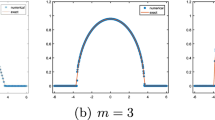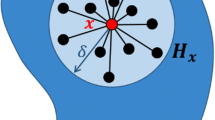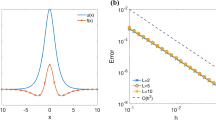Abstract
We describe an approach to treating initial-boundary-value problems by finite volume methods in which the parallel between differential and difference arguments is closely maintained. By using intrinsic geometrical properties of the volume elements, we are able to describe discrete versions of the div, curl, and grad operators which lead, using summation-by-parts techniques, to familiar energy equations as well as the div curl=0 and curl grad=0 identities. For the diffusion equation, these operators describe compact schemes whose convergence is assured by the energy equations and which yield both the potential and the flux vector with second-order accuracy. A simplified potential form is especially useful for obtaining numerical results by multigrid and ADI methods. The treatment of general curvilinear coordinates is shown to result from a specialization of these general results.
Similar content being viewed by others
References
Brezzi, F. (1988). A survey of mixed finite element methods, inFinite Elements: Theory and Applications, Dwoyer, Hussaini, and Voigt, (eds.), Springer-Verlag, New York, pp. 34–49.
Gatski, T. B., Grosch, C. E., and Rose, M. E. (1989). The numerical solution of the Navier-Stokes equations for three-dimensional, unsteady, incompressible flows by compact schemes,J. Comput. Phys. 82, 298–329.
Kreiss, H. O. (1964). On difference approximations of the dissipative type for hyperbolic equations,Commun. Pure Appl. Math. 17, 335–353.
Lustman, L. R., and Rose, M. E. (1988). A three dimensional calculation of elastic equilibrium for composite materials,Int. J. Num. Methods Eng. 26, 953–971.
Peyret, R., and Taylor, T. D. (1983).Computational Methods for Fluid Flow, Springer-Verlag, New York.
Rose, M. E. (1985). A compact finite element method for elastic bodies,Num. Methods Part. Diff. Eg. 3, 209–228.
Rose, M. E. (1983). Compact finite difference schemes for the Euler and Navier-Stokes equations,J. Comput. Phys. 49, 420–442.
Strang, G., and Fix (1973).An Analysis of the Finite Element Method, Prentice-Hall, Englewood Cliffs, New Jersey.
Vinokur, M. (1989). An analysis of finite-difference and finite-volume formulations of conservation laws,J. Comput. Phys. 81, 1–52.
Author information
Authors and Affiliations
Rights and permissions
About this article
Cite this article
Rose, M.E. Compact finite volume methods for the diffusion equation. J Sci Comput 4, 261–290 (1989). https://doi.org/10.1007/BF01061058
Received:
Issue Date:
DOI: https://doi.org/10.1007/BF01061058




